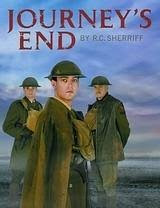Theatre Review: World War, not Class War
‘Journey’s End’ by R.C. Sherriff. The Duke of York’s Theatre, London.
Once there was a war in which men walked into battle kicking footballs, with  rum on their last dying breaths, lead by officers in riding breeches carrying silver-topped canes.
rum on their last dying breaths, lead by officers in riding breeches carrying silver-topped canes.
 rum on their last dying breaths, lead by officers in riding breeches carrying silver-topped canes.
rum on their last dying breaths, lead by officers in riding breeches carrying silver-topped canes.Whilst equal through the sights of a Maxim gun, in the last analysis class separated them as effectively as no-man’s-land kept them apart from the enemy. Although the ordinary Tommy or Hun possessed some degree of loyalty to their officers, class underpinned all social relationships to the extent that the average soldier often felt more in common with his enemy counterpart than with his own superiors.
This, of course, was the First World War, in which R. C. Sherriff’s play Journey’s End is set. As a teenaged officer, Sherriff saw action at the Somme and later at Passchendale where he received a ‘Blighty’ (was wounded badly enough to be sent back to Britain). Thus his play has what Remarque’s contemporaneous All Quiet on the Western Front also has: the authority of first-hand experience. Indeed, the believability of the play is one of its strengths. Set solely in a front-line dug out, the story concerns the relations between a group of officers as they await the start of Germany’s 1918 Spring offensive. Raleigh, a rosy-cheeked 18-year-old fresh from the playing fields of Eton or Harrow, meets Stanhope, his childhood hero from school and now a hard-bitten whiskey-driven veteran of 21, who immediately resents the return of the fawning teenager into his life. The laid-back leadership style of 40-year-old Osborne, ‘Uncle’ to the youngsters, affects a calming influence as he comes between the petulant youngsters like a relentlessly understanding class tutor. ‘Dear old Uncle, tuck me up’, says an exhausted Stanhope from his bunk and in a moment of tenderness it’s as if a patient father is putting to bed his straying but essentially decent son. The play concludes with a touching reconciliation between Stanhope and Raleigh before the naïve youngster’s inevitable death.
But a play about the officer class would not be complete without its representatives of the common soldiery. After all, the officers need their servants and clowns as much as Shakespeare’s aristocrats needed their Bottoms, Pistols and Porters. Sherriff gives us Trotter and Mason, the former a mercilessly chirpy Cockney promoted from the ranks to officer status who walks eye-deep in hell with a song and a smile; the latter the dug-out dogsbody treated like a servant even in these conditions and whose lines mainly concern the dietary requirements of the officers. There is something comical about these two characters, something of the Sam Weller ‘wery pleased to make your haquaintance, sah‘, something you are meant to laugh at. This only may be to provide some light relief for the fraught situation, but you are not meant to laugh at the other characters — you are meant to understand and empathise with them. Being working class, at best they are shrewd but, lacking the formal education of the others, contribute little to the gravitas of the play other than to make remarks such as ‘these hapricots is gorn orf, sah’. One would not want an Owen to walk into the trenches to teach Tommies socialism, however, for it would not work in the context of the play. Journey’s End after all is concerned solely with the officer class and so there is not the space for serious and intelligent working class characters (whereas there is in Miles Malleson’s D Company and Black Ell). Unfortunately, 75 years after the play opened, there still seems little room for serious and intelligent working class characters in theatre, film and TV. But that’s another story.
Despite this, Sherriff’s play is a powerful and memorable piece of theatre which succeeded to entertain and move its audience. Whilst relegating the noticeably working class characters to minor or frivolous roles, it does offer what is probably a faithful account of upper-class men at war.
Nick White
